The first thing I saw was Crow. It was almost as if I was looking through a camera, and Crow put his face right up to the lens. He put his eyeball up to the lens, and then his beak, then his whole face, and then he vanished.
The next thing I saw was an enormous, gorgeous, perfect rose, free floating in mid-air. It was very dark pink, almost red, and then it became a lush, deep, dark red. It had petals like a peony, but it was a rose. The rose became larger and larger, and as it grew, it opened to reveal a velvety center of infinite petals.
I was on the edge of a forest. Eagle appeared, in a fierce emanation. I got onto his back.
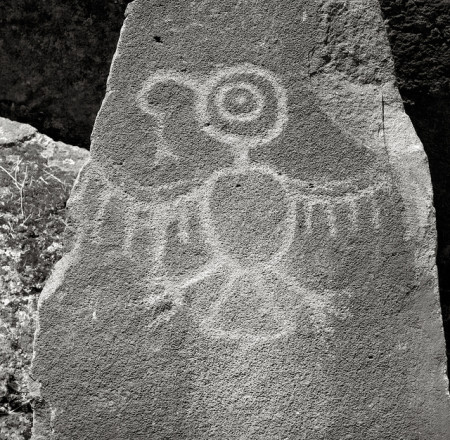
Thunderbird Petroglyph, Horse thief lake, OR.
Then he and I climbed into the rose and were immediately transported up into the sky on a strong current of wind. Raccoon came running up behind us, and at the last minute grabbed onto the rose and came flying with us. Crow flew up beside us and flew along, by our side. As we climbed high into the sky, I looked down and saw two dead animals at the forest’s edge; a doe and a kit fox. I could see smoke coming from the treetops and I realized there must be a forest fire. It appeared that the doe and the kit fox had possibly died of smoke inhalation.
We were scaling a mountainside. There was a cliff jutting out, way above us. It was above the cloud line. We went through the layer of clouds, very swiftly, and landed on the edge of the cliff. Grandmother Rose was there. She had been waiting for us. There was also a leathery old medicine man. He was half man and half crow, and he called himself Crow Dancer. He had a man’s head and was wearing a crow feather hood with a crow beak. He had crow wings, and he wore a fringed elk hide robe. Rose had been preparing for this retrieval.

First, she pulled out a wonderful medicine blanket that she made for as a gift. It was very long, and when she unfurled it, the length of it tumbled over the cliff for many yards. As she began to gather it back up into a neat roll, she smiled lovingly. She had spent many moons making this blanket, and each stitch contained a prayer. This blanket had very powerful protective medicine. She placed the rolled-up medicine blanket into the saddlebag on the Eagle. Then she handed me a magic compass. The compass was made entirely of quartz crystal. She showed me precisely how to use it for navigation. The face of the compass was completely blank, empty of all markings. It had a clear crystal face, with a quartz crystal needle. The compass would guide us on our journey. Finally, she handed me a key, carved out of jade. I placed the key in my medicine pouch. Crow Dancer danced around and flapped his wings and stomped his feet and made a blessing for the journey, and we were off again.
As soon as we started flying, we were joined by a magnificent phoenix. It came swooping from around the back of the mountain, began flying beside us, and then quickly pulled out in front of us and began to lead the way. We flew downward now, like bullets, and plunged into the ocean with incredible force and speed. We went down down down to the very bottom of the ocean and came to the mouth of a cave.
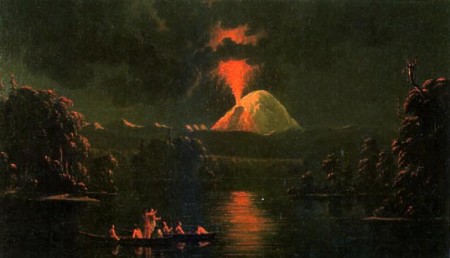
Paul Kane painting of Loowit (Mt. St. Helens), which was a symbol of rebirth to the Cowlitz People.
The cave was guarded by a blue dragon. The phoenix approached the dragon and requested permission to enter the cave. The dragon asked the phoenix what business he had in the cave, and the phoenix replied that he had come to “get his boy.” The dragon gave him three challenges. He challenged him to a game of chinese checkers. The phoenix won. He challenged him to a fire breathing contest. The phoenix won. And finally, he asked the phoenix to guess his name. The phoenix went up to the dragon and whispered something in the dragon’s ear. The dragon looked at him, utterly astonished, and granted entry. The dragon breathed fire up into the ceiling above the entry of the cave, and a trap door opened. We all went in. We found ourselves in a very narrow, tight tunnel. It was so narrow and tight that we barely had room to move. The only way was for us to make ourselves smaller and to keep moving, otherwise we would get stuck. I couldn’t see a thing. There were so many twists and turns that it made me dizzy. I remembered the magic compass. As soon as I pulled it out of my medicine pouch, the needle on the compass began to glow and pulse. The needle quivered for a moment and then pointed very strongly in a particular direction, which we followed. After that we were fine. We just followed the glowing compass needle through the labyrinthine tunnels and eventually came out into a part of the cave that had a large central clearing. There were several openings and cave mouths all along the perimeter. However, the compass showed us precisely where to go. We followed it’s guidance to one particular little cave entrance, with its door locked up tight. I took out the jade key and placed it in the lock. It fit perfectly, and with one turn of the key, the door flew open and there we found a little boy. He was curled up in a corner, lying on his left side, with his arms around his knees, huddled up against the cold, wet corner of the cave. He had his face to the corner of the cave and his back to us, and even though he heard us come in, it took a long time for him to stir.
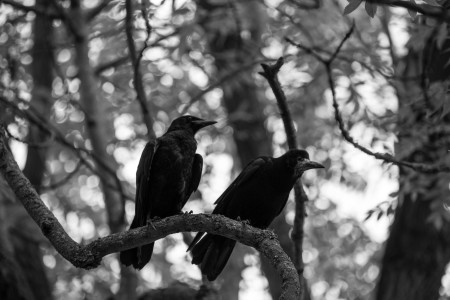
Crow teachers. Public domain photo
He looked to be around seven years old. He had long dark hair, and he looked terribly sad. His eyes were large and melancholy and he would not make eye contact. Crow went up to him to try to make eye contact. Then he hopped up onto the boy’s left shoulder and told him that we were here to take him home, if he would like to come with us. The boy just sat there as if he hadn’t heard a word. Crow asked the boy if he liked it there, in the cave. The boy shook his head slowly. “No, not really.” said the boy. “Would you like to come home?” asked Crow. “I don’t know.” Crow explained to the boy that things were different now, and that he would be safe. He told the boy that he had been missed and that he was loved, and that he would be welcomed back home with open arms. The boy indicated that he would like to come with us. I reached into the saddlebag for the medicine blanket, and wrapped it around the boy. He knew who had made it. I didn’t have to say a word. Now, when I looked at his face, he looked older, closer to maybe eleven years old or so. After this, his face would change, and his features would become those of a younger boy, then an older boy. But he was always somewhere between seven and eleven years old.
Crow stayed on his left shoulder. Phoenix stepped forward so the boy could climb onto his back. I followed with Eagle and we quickly exited the dank cave. As we left, Phoenix dropped a colorful tail feather, as an offering to Dragon, and Dragon picked it up and waved. We shot back up through the ocean, just as we had shot down, and we found ourselves back at the cliff. Grandmother Rose was there. Crow Dancer was there. Grandmother Rose embraced the boy for a long time. She pulled him onto her lap and rocked him and kissed him and hummed to him. She pulled the medicine blanket snugly around him and sighed. Crow Dancer placed a breastplate of porcupine quills on the boy and gave him his elk skin robe. Grandmother Rose took the boy’s long hair and divided it into three sections. She made three braids, and then braided those three braids into a single braid. She talked about the power of three, that three was the number to keep in mind. Crow Dancer placed three big shiny black crow feathers in the boy’s hair. Phoenix placed more feathers in the boy’s hair, magnificent feathers of brilliant hues; red, orange, yellow, violet, blue, green…He gave the boy a walking stick on which was carved: “NOW IS THE MOMENT OF POWER.” Grandmother Rose told the boy that it was important to forget the past, and to not worry about the future. “Life is short,” she said. “All we have is this moment.” Spider made an appearance and wove a cloak of scintillating light around the boy. It sparkled and shined with a pure radiance. She said that all he ever needed to do, if he ever got scared, was to ask Spider for a cloak of light, and she would weave something up for him. He will always have access to protection. All he has to do is ask.
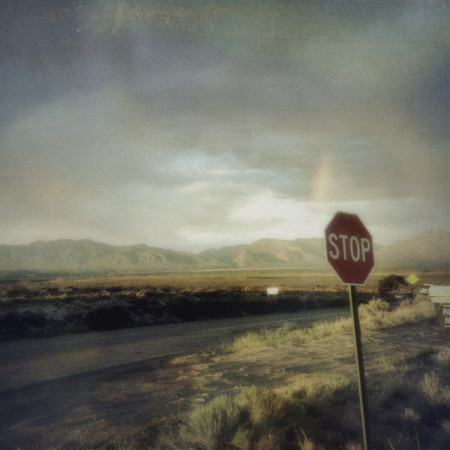
Mesa near Taos, NM.
H a v e n © 2016
There were embraces and acknowledgements and blessings, and then it was time to say goodbye. We climbed down a ladder made of rainbow light and came to an open, grassy field. It was just outside the same edge of forest from which our journey had begun. Many animals began to appear and quickly disappear; Raccoon, Red Tailed Hawk, Bighorn Sheep, Unicorn, Coyote. As we landed on the grassy field, we joined a fire ceremony that was being held in the boy’s honor. The boy stood at the fire, wearing a white mask. Raccoon came up to him and took off the boy’s mask and tossed it into the fire, where it was consumed. There was another mask underneath. Again, Raccoon took off the mask and tossed it into the fire. This went on and on, mask after mask. The first masks were completely opaque, but as they continued to be peeled away they became more transparent. I could see through the final mask, and I saw that the boy was weeping. Raccoon stood there and looked at the boy with great compassion. Raccoon was not going to take off the final mask. The boy wept for a long time at the fire. Finally, he reached up and slowly removed the final mask, and placed it quietly into the flames. The boy’s face softened and he stopped crying. Everyone laughed and cheered and came over and embraced the boy. He was glad to be home.
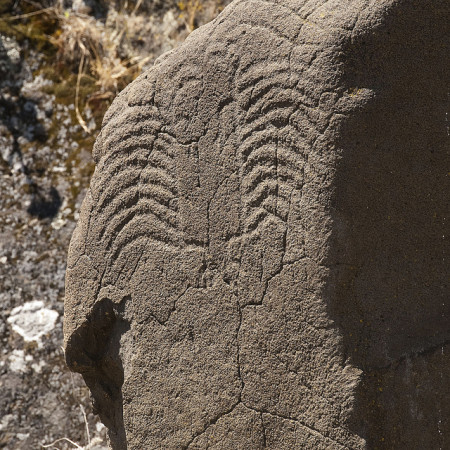 Including both pictographs (paintings) and petroglyphs (carvings), the rock art at these sites was created as early as 7,000 years ago until as recently as the late 1800s. Although petroforms—a third type of rock art composed of outlines cut in desert pavement or boulders laid out in the form of animals or humans—are found elsewhere in North America, none has been discovered in Oregon.
Including both pictographs (paintings) and petroglyphs (carvings), the rock art at these sites was created as early as 7,000 years ago until as recently as the late 1800s. Although petroforms—a third type of rock art composed of outlines cut in desert pavement or boulders laid out in the form of animals or humans—are found elsewhere in North America, none has been discovered in Oregon.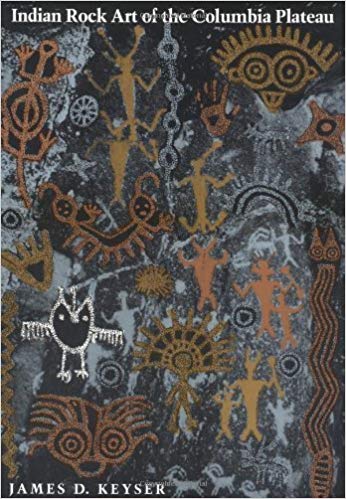
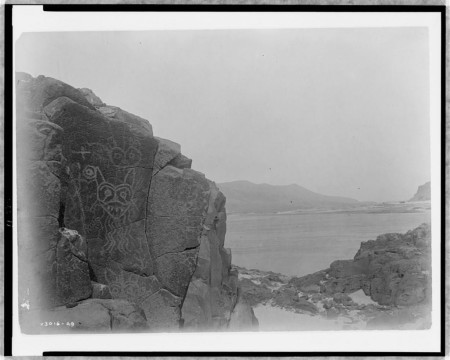
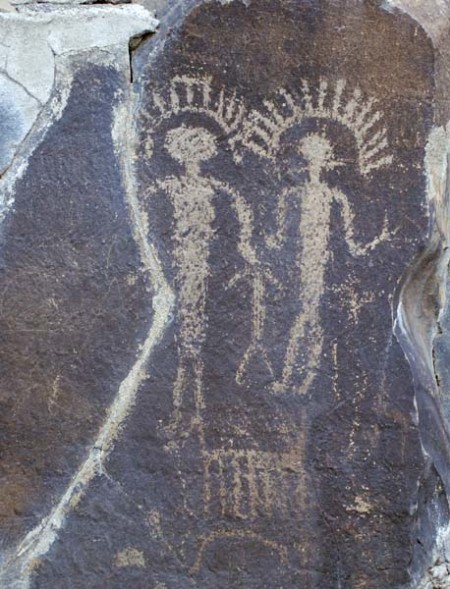
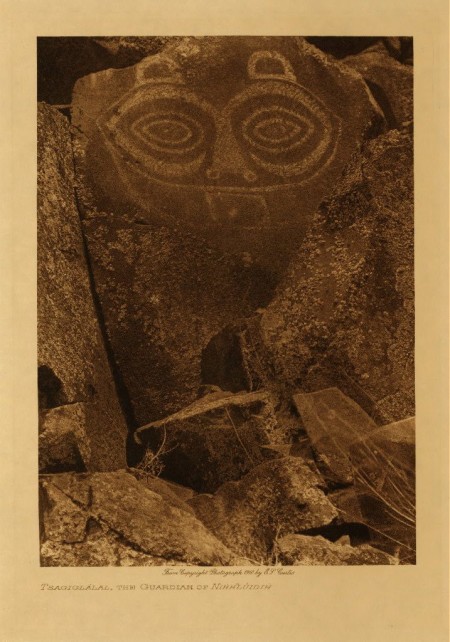 God call them home? The few survivors walked away dazed. Took to speaking other languages. Were replaced by strangers. After a few decades hardly anyone remembered that they had ever been there.”
God call them home? The few survivors walked away dazed. Took to speaking other languages. Were replaced by strangers. After a few decades hardly anyone remembered that they had ever been there.”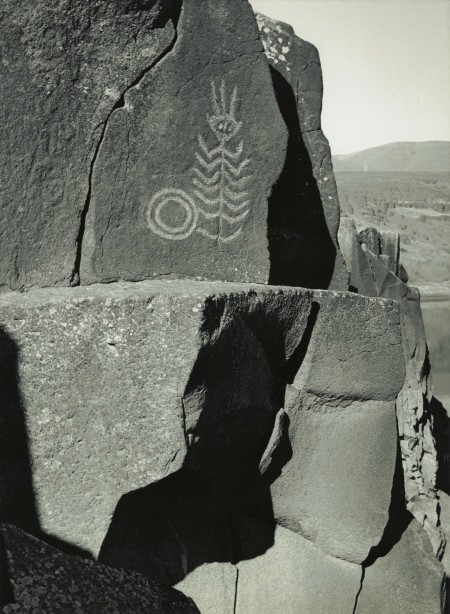
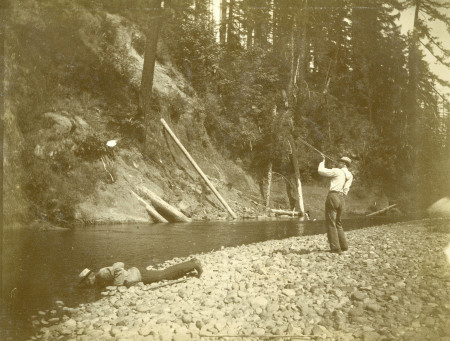
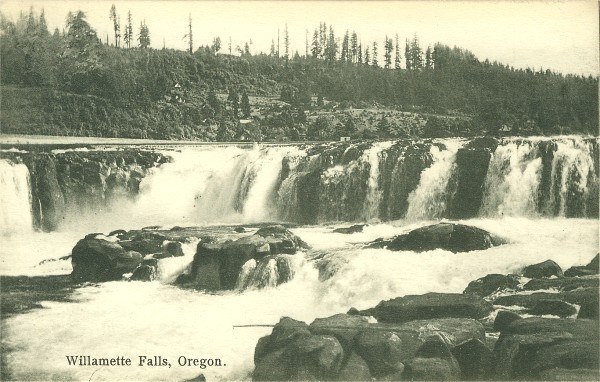 All the Indians came and began to fish. Now Coyote made his magic fish trap. He made it so it would speak, and say Noseepsk! when it was full. Because he was pretty hungry, Coyote decided to try it first himself. He set the trap by the Falls, and then ran back up the shore to prepare to make a cooking fire. But he had only begun when the trap called out, “Noseepsk!”
All the Indians came and began to fish. Now Coyote made his magic fish trap. He made it so it would speak, and say Noseepsk! when it was full. Because he was pretty hungry, Coyote decided to try it first himself. He set the trap by the Falls, and then ran back up the shore to prepare to make a cooking fire. But he had only begun when the trap called out, “Noseepsk!”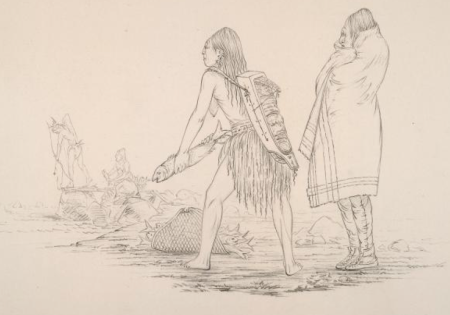
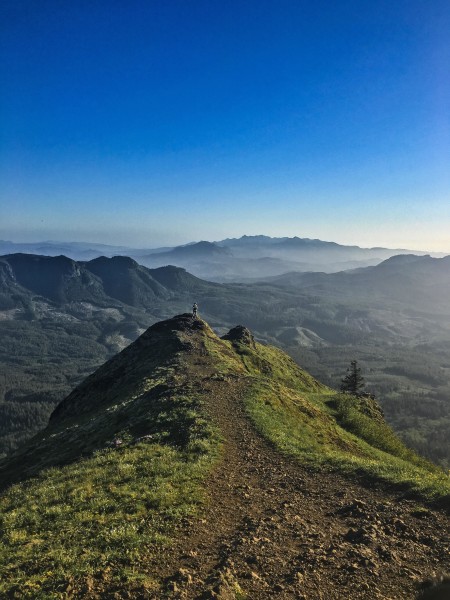
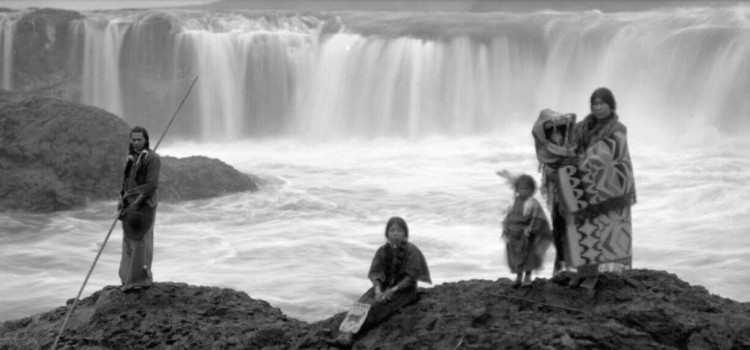
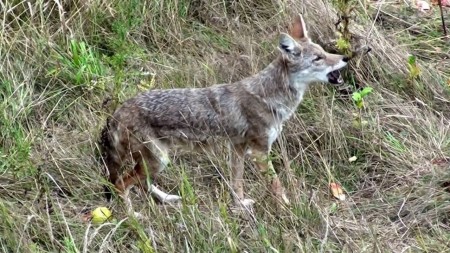 At Niâ’xaqcê a creek originated. He went and built a house at Niâ’xaqcê. He went out and stayed at the month of Niâ’xaqcê. Then he speared two silver-side salmon, a steel-head salmon, and a fall salmon. Then he threw the salmon and the fall salmon away, saying: “This creek is too small. I do not like to see here salmon and fall salmon. It shall be a bad omen when a fall salmon is killed here; somebody shall die; also when a salmon is killed. When a female salmon or fall salmon is killed a woman shall die; when a male is killed a man shall die.” Now he carried only the silver-side salmon to his house. When he arrived there he cut it at once, steamed it and ate it. On the next day he took his harpoon and went again to the mouth of Niâ’xaqcê. He did not see anything, and the flood tide set in. He went home. On the next day he went again and did not see anything. Then he became angry and went home. He defecated and said to his excrements: “Why have these silver-side salmon disappeared?” “Oh, you with your bandy legs, you have no sense. When the first silver-side salmon is killed it must not be cut. It must be split along its back and roasted. It must not be steamed. Only when they go up river then they may be steamed.” Coyote went home. On the next day he went again and speared three. He went home and made three spits. He roasted each salmon on a spit. He had three salmon and three spits. On the next day he went again and stood at the month of the creek. He did not see anything until the flood tide set in. Then he became angry and went home. He defecated. He spoke and asked his excrements: “Why have these silver-side salmon disappeared?” His excrements said to him: “I told you, you with your bandy legs, when the first silver-side salmon are killed spits must be made, one for the head, one for the back, one for the roe, one for the body. The gills must be burnt.” “Yes,” said
At Niâ’xaqcê a creek originated. He went and built a house at Niâ’xaqcê. He went out and stayed at the month of Niâ’xaqcê. Then he speared two silver-side salmon, a steel-head salmon, and a fall salmon. Then he threw the salmon and the fall salmon away, saying: “This creek is too small. I do not like to see here salmon and fall salmon. It shall be a bad omen when a fall salmon is killed here; somebody shall die; also when a salmon is killed. When a female salmon or fall salmon is killed a woman shall die; when a male is killed a man shall die.” Now he carried only the silver-side salmon to his house. When he arrived there he cut it at once, steamed it and ate it. On the next day he took his harpoon and went again to the mouth of Niâ’xaqcê. He did not see anything, and the flood tide set in. He went home. On the next day he went again and did not see anything. Then he became angry and went home. He defecated and said to his excrements: “Why have these silver-side salmon disappeared?” “Oh, you with your bandy legs, you have no sense. When the first silver-side salmon is killed it must not be cut. It must be split along its back and roasted. It must not be steamed. Only when they go up river then they may be steamed.” Coyote went home. On the next day he went again and speared three. He went home and made three spits. He roasted each salmon on a spit. He had three salmon and three spits. On the next day he went again and stood at the month of the creek. He did not see anything until the flood tide set in. Then he became angry and went home. He defecated. He spoke and asked his excrements: “Why have these silver-side salmon disappeared?” His excrements said to him: “I told you, you with your bandy legs, when the first silver-side salmon are killed spits must be made, one for the head, one for the back, one for the roe, one for the body. The gills must be burnt.” “Yes,” said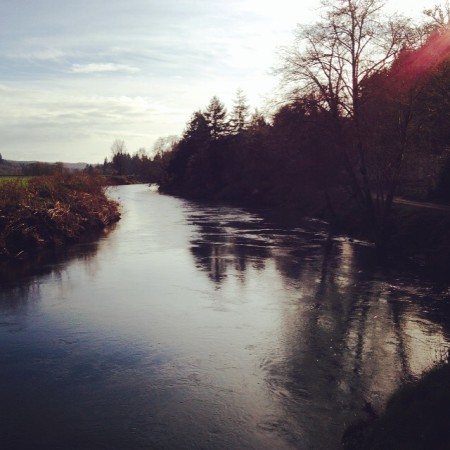
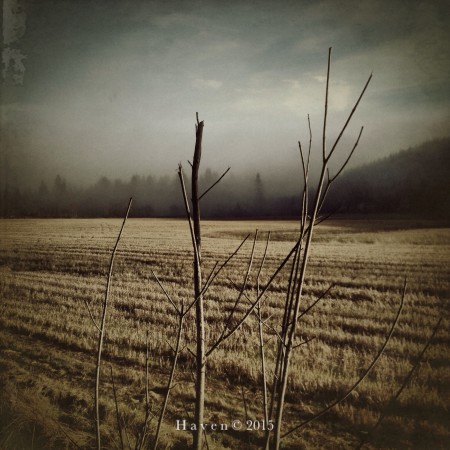
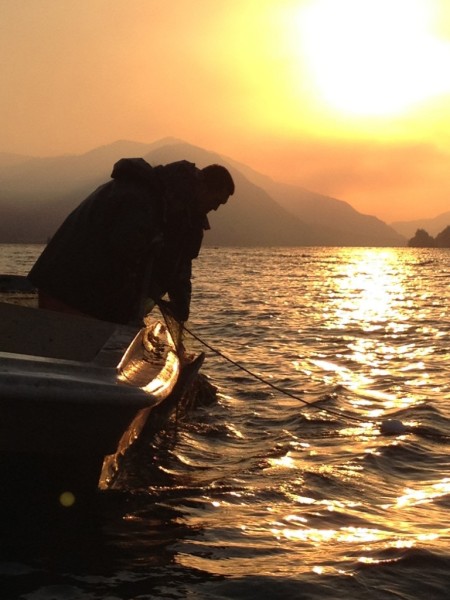
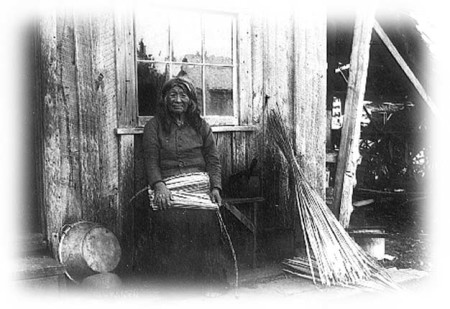
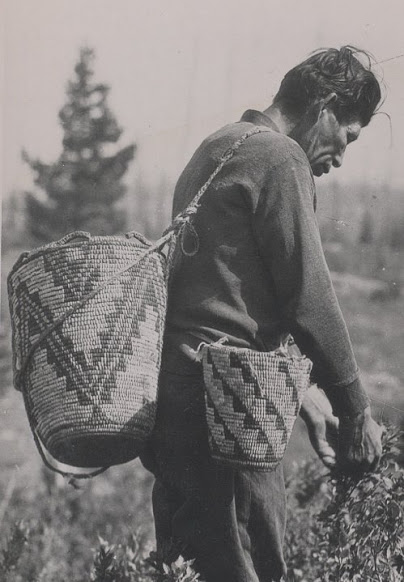
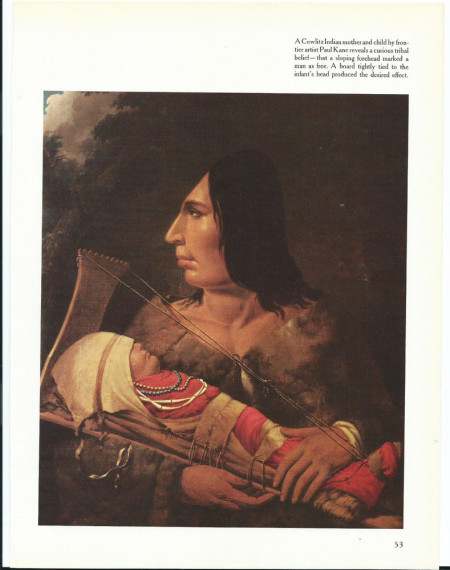
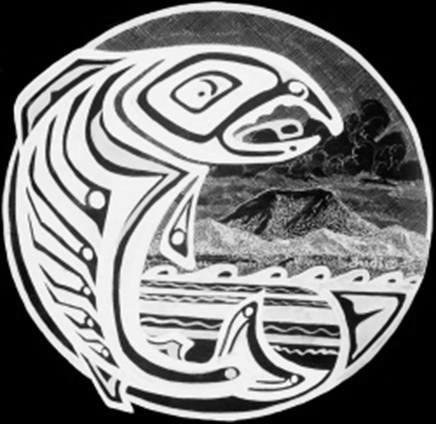

 First, she pulled out a wonderful medicine blanket that she made for as a gift. It was very long, and when she unfurled it, the length of it tumbled over the cliff for many yards. As she began to gather it back up into a neat roll, she smiled lovingly. She had spent many moons making this blanket, and each stitch contained a prayer. This blanket had very powerful protective medicine. She placed the rolled-up medicine blanket into the saddlebag on the Eagle. Then she handed me a magic compass. The compass was made entirely of quartz crystal. She showed me precisely how to use it for navigation. The face of the compass was completely blank, empty of all markings. It had a clear crystal face, with a quartz crystal needle. The compass would guide us on our journey. Finally, she handed me a key, carved out of jade. I placed the key in my medicine pouch. Crow Dancer danced around and flapped his wings and stomped his feet and made a blessing for the journey, and we were off again.
First, she pulled out a wonderful medicine blanket that she made for as a gift. It was very long, and when she unfurled it, the length of it tumbled over the cliff for many yards. As she began to gather it back up into a neat roll, she smiled lovingly. She had spent many moons making this blanket, and each stitch contained a prayer. This blanket had very powerful protective medicine. She placed the rolled-up medicine blanket into the saddlebag on the Eagle. Then she handed me a magic compass. The compass was made entirely of quartz crystal. She showed me precisely how to use it for navigation. The face of the compass was completely blank, empty of all markings. It had a clear crystal face, with a quartz crystal needle. The compass would guide us on our journey. Finally, she handed me a key, carved out of jade. I placed the key in my medicine pouch. Crow Dancer danced around and flapped his wings and stomped his feet and made a blessing for the journey, and we were off again.

